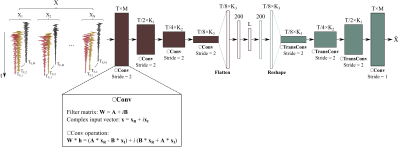Yahang Li1,2, Zepeng Wang1,2, and Fan Lam1,2
1Department of Bioengineering, University of Illinois Urbana-Champaign, Urbana, IL, United States, 2Beckman Institute for Advanced Science and Technology, University of Illinois Urbana-Champaign, Urbana, IL, United States
1Department of Bioengineering, University of Illinois Urbana-Champaign, Urbana, IL, United States, 2Beckman Institute for Advanced Science and Technology, University of Illinois Urbana-Champaign, Urbana, IL, United States
A new learning-based method
that exploits the nonlinear low-dimensional representations of multi-TE MRSI
data was proposed for SNR enhancement. Simulation and experimental results
demonstrated the effectiveness and superior performance over alternative
denoising methods.

Figure 1: The proposed DCCAE and training
strategy. X denotes the collection of multi-TE FID training data with length T
and M TEs. Complex units are used where different TEs
are treated as different channels in the input. For each complex convolution block, data
dimensions were reduced by half while the channel dimension (K) increased by a
small amount. The fully connected part followed an encoder-decoder structure and
a middle feature layer with dimension $$$L$$$ (referred to as the model
order). Errors between $$$\textbf{X}$$$ and $$$\hat{\textbf{X}}$$$ is minimized.

Figure 2:
Representation efficiency of the learned model: a) Relative $$$\ell_2$$$ errors
of the proposed model approximation with different model orders $$$L$$$’s for
3-TE data (orange curve), compared to linear subspace models (TE-combined
subspace in the blue curve and TE-dependent subspace in a yellow curve). For
the TE-dependent subspaces, $$$L$$$ is the total dimension of the three
subspaces. b) Approximations of a test spectra at different TEs (30, 80,
and 130 ms) using the three models with $$$L = 42$$$. A more accurate
representation is achieved by our learned model.
